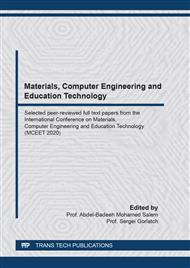[1]
E.J. Mittemeijer, M.A.J. Somers, Thermochemical Surface Engineering of Steels, first ed., Woodhead Publishing, Cambridge, (2015).
Google Scholar
[2]
E. Conrado, C. Gorla, P. Davoli, M. Boniardi, A comparison of bending fatigue strength of carburized and nitrided gears for industrial applications, Eng. Fail. Anal. 78 (2017) 41–54.
DOI: 10.1016/j.engfailanal.2017.03.006
Google Scholar
[3]
Y. Shen, S. Mobasher Moghadam, F. Sadeghi, K. Paulson, R.W. Trice, Effect of retained austenite – compressive residual stresses on rolling contact fatigue life of carburized AISI 8620 steel, Int. J. Fatigue. 75, (2015) 135–144.
DOI: 10.1016/j.ijfatigue.2015.02.017
Google Scholar
[4]
J. Grosch, Fatigue resistance of carburized and nitrided steels, in: E.J. Mittemeijer, M.A.J. Somers (Eds.), Thermochemical Surface Engineering of Steels, Woodhead Publishing, Oxford, 2015, p.209–240.
DOI: 10.1533/9780857096524.2.209
Google Scholar
[5]
S.Kh. Alias, B. Abdullah, A. Jaffar, S. Abdul Latip, S. Kasolang, M. Faizul Izham, M. Azimin Abd Ghani, Mechanical properties of paste carburized ASTM A516 steel, Procedia Engineer. 68 (2013) 525–530.
DOI: 10.1016/j.proeng.2013.12.216
Google Scholar
[6]
B. Jo, Sh. Sharifimehr, Y. Shim, A. Fatemi, Cyclic deformation and fatigue behavior of carburized automotive gear steel and predictions including multiaxial stress states, Int. J. Fatigue. 100 (2017) 454–465.
DOI: 10.1016/j.ijfatigue.2016.12.023
Google Scholar
[7]
A. Nehila, W. Li, N. Gao, X. Xing, H. Zhao, P. Wang, T. Sakai, Very high cycle fatigue of surface carburized CrNi steel at variable stress ratio: Failure analysis and life prediction, Int. J. Fatigue. 111 (2018) 112–123.
DOI: 10.1016/j.ijfatigue.2018.02.006
Google Scholar
[8]
S. Farfa´n, C. Rubio-Gonza´lez, T. Cervantes-Herna´ndez, G. Mesmacque, High cycle fatigue, low cycle fatigue and failure modes of a carburized steel, Int. J. Fatigue. 26 (2004) 673–678.
DOI: 10.1016/j.ijfatigue.2003.08.022
Google Scholar
[9]
T.M. Loganathan, J. Purbolaksono, J.I. Inayat-Hussain, N. Wahab, Effects of carburization on expected fatigue life of alloys steel shafts, Mater. Design. 32 (2011) 3544–3547.
DOI: 10.1016/j.matdes.2011.02.004
Google Scholar
[10]
Y. Yang, M.F. Yan, S.D. Zhang, J.H. Guo, S.S. Jiang, D.Y. Li, Diffusion behavior of carbon and its hardening effect on plasma carburized M50NiL steel: Influences of treatment temperature and duration, Surf. Coat. Tech. 333 (2018) 96–103.
DOI: 10.1016/j.surfcoat.2017.10.068
Google Scholar
[11]
N. Xiao, W. Hui, Y. Zhang, X. Zhao, Y. Chen, H. Dong, High cycle fatigue behavior of a low carbon alloy steel: The influence of vacuum carburizing treatment, Eng. Fail. Anal. 109 (2019) 104215,.
DOI: 10.1016/j.engfailanal.2019.104215
Google Scholar
[12]
W. Li, S. Deng, B. Liu, Experimental study on the influence of different carburized layer depth on gear contact fatigue strength, Eng. Fail. Anal. 107 (2019) 104225,.
DOI: 10.1016/j.engfailanal.2019.104225
Google Scholar
[13]
I. Čular, K. Vučković, D. Žeželj, S. Glodež, Analytical approach for low and high cycle bending fatigue life prediction of carburized gear steel specimens, Eng. Fail. Anal. 108 (2019) 104328,.
DOI: 10.1016/j.engfailanal.2019.104328
Google Scholar
[14]
M.Z. Hasan, A.A. Hussein, A.Sh. Hasan, O.M. Ali, Improvement of AISI 1018 Carbon Steel Gr 1018 mechanical properties by liquid carburizing in salt bath, Mater. Today Proc. 20 (2019) 512–516.
DOI: 10.1016/j.matpr.2019.09.179
Google Scholar
[15]
Y. Peng, Z. Liu, C. Chen, J. Gong, M.A.J. Somers, Effect of low-temperature surface hardening by carburization on the fatigue behavior of AISI 316L austenitic stainless steel, Mat. Sci. Eng. A-Struct. 769 (2020) 138524,.
DOI: 10.1016/j.msea.2019.138524
Google Scholar
[16]
Z. Liu, Y. Peng, C. Chen, J. Gong, Y. Jiang, Effect of surface nanocrystallization on low-temperature gas carburization for AISI 316L austenitic stainless steel, Int. J. Pres. Ves. Pip. 182 (2020) 104053,.
DOI: 10.1016/j.ijpvp.2020.104053
Google Scholar
[17]
M. Vamshi, S.K. Singh, N. Sateesh, D.S. Nagaraju, R. Subbiah, A review on influence of carburizing on ferritic stainless steel, Mater. Today Proc. 26 (2020) 937–943.
DOI: 10.1016/j.matpr.2020.01.151
Google Scholar
[18]
W.D. Callister, D.G. Rethwisch, Materials Science and Engineering, An Introduction, 9th edition, John Wiley & Sons, New Jersey, (2014).
Google Scholar
[19]
G.L. Tibbetts, Diffusivity of carbon in iron and steels at high temperatures, J. Appl. Phys. 51 (1980) 4813–4816.
DOI: 10.1063/1.328314
Google Scholar
[20]
M.M.A. Bepari, Carburizing: a method of case hardening of steel, in: M.S.J. Hashmi, I.A. Choudhury (Eds.), Comprehensive Materials Finishing, Volume 1 Finish Machining and Net-Shape Forming, Elsevier, Oxford, 2017, p.71–107.
DOI: 10.1016/b978-0-12-803581-8.09187-6
Google Scholar
[21]
Metals Handbook, Vol. 4 Heat Treating, 8th ed.; American Society for Metals, Metals Park, Ohio, 1971, p.93–114.
Google Scholar
[22]
ASTM E468–18: Standard practice for presentation of constant amplitude fatigue test results for metallic materials, American Society for Testing and Materials: West Conshohocken, (2018).
Google Scholar
[23]
ASTM E466–15: Standard practice for conducting force controlled constant amplitude axial fatigue tests of metallic materials, American Society for Testing and Materials: West Conshohocken, (2012).
DOI: 10.1520/e0466-21
Google Scholar
[24]
R.G. Budynas, J.K. Nisbett, Shigley's Mechanical Engineering Design, 10th Ed., McGraw-Hill Higher Education, New York, 2015, p.305–364.
Google Scholar
[25]
H. Mao, Q. Li, H. Mao, Z. Huang, W. Tang, H. Huang, X. Yi, G. Qing, X. Li, Nonlinear ultrasonic characterization of carburized case depth, NDT & E Int. 112 (2020) 102244,.
DOI: 10.1016/j.ndteint.2020.102244
Google Scholar


